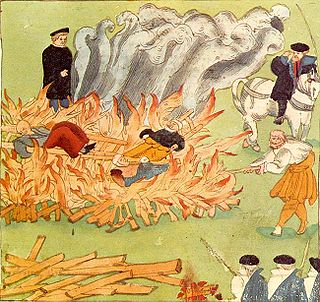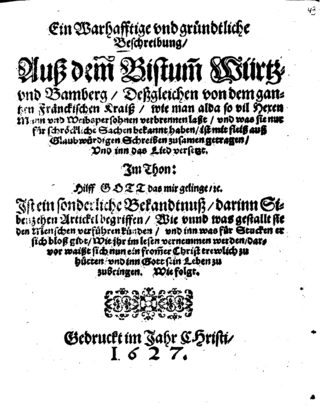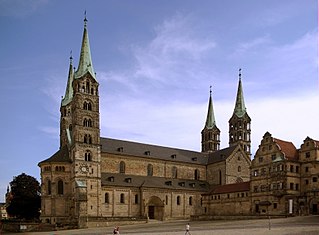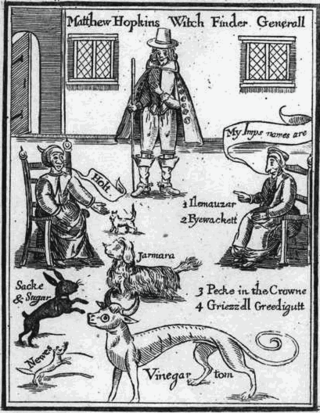
A witch-hunt, or a witch purge, is a search for people who have been labeled witches or a search for evidence of witchcraft. The classical period of witch-hunts in Early Modern Europe and Colonial America took place in the Early Modern period or about 1450 to 1750, spanning the upheavals of the Reformation and the Thirty Years' War, resulting in an estimated 35,000 to 50,000 executions. The last executions of people convicted as witches in Europe took place in the 18th century. In other regions, like Africa and Asia, contemporary witch-hunts have been reported from sub-Saharan Africa and Papua New Guinea, and official legislation against witchcraft is still found in Saudi Arabia and Cameroon today.

Derenburg is a town in the district of Harz, in Saxony-Anhalt, Germany. Since 1 January 2010, it has been part of the Blankenburg am Harz municipality.
Malin Matsdotter or Mattsdotter, also known as Rumpare-Malin was an alleged Swedish witch. She is known as one of few people in Sweden confirmed to have been executed by burning for witchcraft, and the only one to be executed by this method during the famous witch hunt Det Stora oväsendet in Sweden during 1668–1676, which ended with her execution.

The Würzburg witch trials of 1625–1631, which took place in the self-governing Catholic Prince-Bishopric of Würzburg in the Holy Roman Empire in present-day Germany, formed one of the biggest mass trials and mass executions ever seen in Europe, and one of the largest witch trials in history.
The Pappenheimer Case centered around a family who were tried and executed for witchcraft in 1600 in Munich, Bavaria, Germany. The family were executed, along with accomplices they were forced to name under torture, after a show trial as scapegoats for a number of unsolved crimes committed years back in a display of extreme torture intended to deter the public from crime. The witch trial resulted in the death of twelve people: four of the Pappenheimer family and two of their accused accomplices in the first trial, followed by the remaining member of the family and five other accomplices in the second trial. The trial was of one of the most well-publicized witch trials in German history.
The witch trials of Vardø were held in Vardø in Finnmark in Northern Norway in the winter of 1662–1663 and were one of the biggest in Scandinavia. Thirty women were put on trial, accused of sorcery and making pacts with the Devil. One was sentenced to a work house, two tortured to death, and eighteen were burned alive at the stake.
Märet Jonsdotter was an alleged Swedish witch. She is one of the most known victims of the persecutions of sorcery in her country; she was the first person accused of this in the great witch hysteria called "Det Stora Oväsendet" of 1668–1676, and her trial unleashed the beginning of the real witch hunt in Sweden, which was to cause the death of around 280 people in those eight years. She was known by the name "Big Märet" because she had a younger sister with the same name called "Small Märet" Jonsdotter.
Witch trials in the early modern period saw that between 1400 to 1782, around 40,000 to 60,000 were killed due to suspicion that they were practicing witchcraft. These trials occurred primarily in Europe, and were particularly severe in some parts of the Holy Roman Empire. Some witch hunts would last for years, and some sources estimate 100,000 trials occurred. Groundwork on the concept of witchcraft was developed by Christian theologians as early as the 13th century. However, prosecutions for the practice of witchcraft would only reach a highpoint from 1560 to 1630 during the Counter-Reformation and the European wars of religion, with some regions burning those who were convicted at the stake, of whom roughly 80% were women,, mostly over the age of 40.

The Finspång witch trial was a witch trial which took place in Finspång Östergötland in Sweden in 1617. Between seven and nine women died as a result. It has a special place in Sweden's history as one of the very few larger witch trials in Sweden outside the period of 1668–1676, which was otherwise the time of the real witch hunt in Sweden. Also because it seems that the condemned were executed by burning, which was not the common way of execution for witch craft in Sweden. It was the biggest witch trial in Sweden before 1668, and resulted in the biggest execution for sorcery in Sweden outside of the 1668–76 witch hunt.

The Bamberg witch trials of 1627–1632, which took place in the self governing Catholic Prince-Bishopric of Bamberg in the Holy Roman Empire in present-day Germany, is one of the biggest mass trials and mass executions ever seen in Europe, and one of the biggest witch trials in history.

The Mora witch trial, which took place in Mora, Sweden, in 1669, is the most internationally famous Swedish witch trial. Reports of the trial spread throughout Europe, and a provocative German illustration of the execution is considered to have had some influence on the Salem witch trials. It was the first mass execution during the great Swedish witch hunt of 1668–1676.
The Thisted witch trial, also known as Besættelsen i Thisted, took place in Thisted in Denmark in 1696–1698. It has been referred to as the last witch trial in Denmark, and the end of the belief in witchcraft among the Danish authorities.

Sweden was a country with few witch trials compared to other countries in Europe. In Sweden, about four hundred people were executed for witchcraft prior to the last case in 1704. Most of these cases occurred during a short but intense period; the eight years between 1668 and 1676, when the witch hysteria called Det stora oväsendet took place, causing a large number of witch trials in the country. It is this infamous period of intensive witch hunt that is most well known and explored and given attention.

The Witch trials in Denmark are poorly documented, with the exception of the region of Jylland in the 1609–1687 period. The most intense period in the Danish witchcraft persecutions was the great witch hunt of 1617–1625, when most executions took place, which was affected by a new witchcraft act introduced in 1617.
Witch trials in Latvia and Estonia were mainly conducted by the Baltic German elite of clergy, nobility and burghers against the indigenous peasantry in order to persecute Paganism by use of Christian demonology and witchcraft ideology. In this aspect, they are similar to the Witch trials in Iceland. They are badly documented, as many would have been conducted by the private estate courts of the landlords, which did not preserve any court protocols.
The witch trials in Poland started later than in most of Europe, beginning in earnest in Poland until the second half of the 17th century, but also lasted longer than elsewhere. Despite being formally banned in 1776, the law was not evenly enforced for the next half a century even after the witch trials had ended or became a rarity in the rest of Europe. It is estimated that between 3,000 and 4,000 people have been executed for sorcery in Poland.

The Witch trials in England were conducted from the 15th century until the 18th century. They are estimated to have resulted in the death of perhaps 500 people, 90 percent of whom were women. The witch hunt was as its most intense stage during the English Civil War (1642–1651) and the Puritan era of the mid-17th century.
The Rottenburg witch trials was a series of witch trials taking place in Rottenburg am Neckar in then Further Austria in present day Baden-Württemberg in Germany between 1578 and 1609. It resulted in the death of 150 people. The witch trials were divided in the waves of 1578-1585, 1589-90, 1595-96, 1598-1605 and 1609. The high peak of the trials were the witch trial of 1595-96, when 41 women were burnt alive at the stake between June 1595 and July 1596. Rottenburg were known as a witch trials center and the 1595 trial attracted attention from the University of Tübingen. The Rottenburg witch trials has been characterized as traditional, since the victims were almost exclusively poor old women, and never developed in to the endemic mass trials in which citizens of all sexes and classes could be indiscriminately accused, such as the Würzburg witch trials, and they were conducted under strict control from the authorities.

The Katarina witch trials took place in the Katarina Parish in the capital of Stockholm in Sweden in 1676. It was a part of the big witch hunt known as the Great noise, which took place in Sweden between the years 1668 and 1676, and it also illustrated the end of it.
Witch trials took place in the Principality of Catalonia in Spain between the 14th-century and 1767. Witch trials were comparably uncommon in Spain, and most of them took place in Catalonia and Navarre. While witch trials were uncommon in the rest of Spain, the witch trials in Catalonia had similarities with the witch trials in the rest of Western Europe, and are therefore a separate chapter in the context of witch trials in Spain. Around 400 women were prosecuted for witchcraft in Catalonia.









